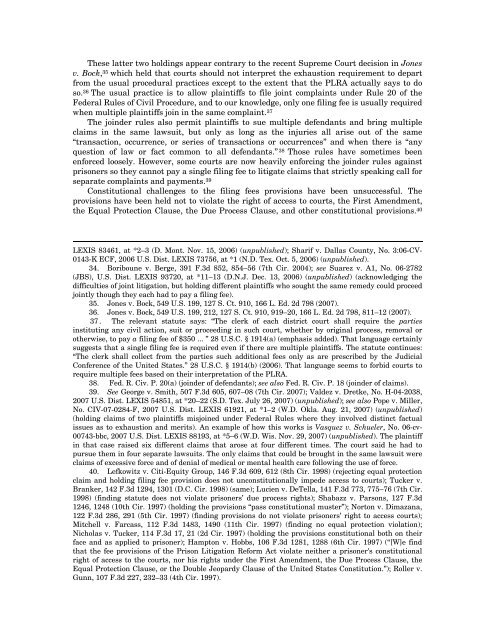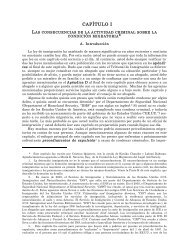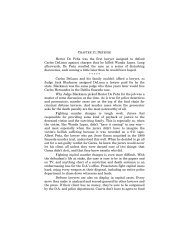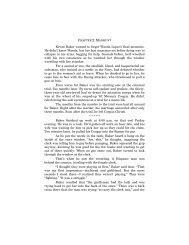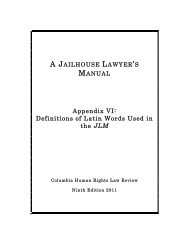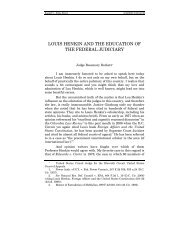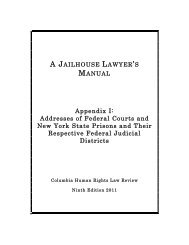A Jailhouse Lawyer's Manual Chapter 14 - Columbia Law School
A Jailhouse Lawyer's Manual Chapter 14 - Columbia Law School
A Jailhouse Lawyer's Manual Chapter 14 - Columbia Law School
You also want an ePaper? Increase the reach of your titles
YUMPU automatically turns print PDFs into web optimized ePapers that Google loves.
These latter two holdings appear contrary to the recent Supreme Court decision in Jones<br />
v. Bock, 35 which held that courts should not interpret the exhaustion requirement to depart<br />
from the usual procedural practices except to the extent that the PLRA actually says to do<br />
so. 36 The usual practice is to allow plaintiffs to file joint complaints under Rule 20 of the<br />
Federal Rules of Civil Procedure, and to our knowledge, only one filing fee is usually required<br />
when multiple plaintiffs join in the same complaint. 37<br />
The joinder rules also permit plaintiffs to sue multiple defendants and bring multiple<br />
claims in the same lawsuit, but only as long as the injuries all arise out of the same<br />
“transaction, occurrence, or series of transactions or occurrences” and when there is “any<br />
question of law or fact common to all defendants.” 38 Those rules have sometimes been<br />
enforced loosely. However, some courts are now heavily enforcing the joinder rules against<br />
prisoners so they cannot pay a single filing fee to litigate claims that strictly speaking call for<br />
separate complaints and payments. 39<br />
Constitutional challenges to the filing fees provisions have been unsuccessful. The<br />
provisions have been held not to violate the right of access to courts, the First Amendment,<br />
the Equal Protection Clause, the Due Process Clause, and other constitutional provisions. 40<br />
LEXIS 83461, at *2–3 (D. Mont. Nov. 15, 2006) (unpublished); Sharif v. Dallas County, No. 3:06-CV-<br />
0<strong>14</strong>3-K ECF, 2006 U.S. Dist. LEXIS 73756, at *1 (N.D. Tex. Oct. 5, 2006) (unpublished).<br />
34. Boriboune v. Berge, 391 F.3d 852, 854–56 (7th Cir. 2004); see Suarez v. A1, No. 06-2782<br />
(JBS), U.S. Dist. LEXIS 93720, at *11–13 (D.N.J. Dec. 13, 2006) (unpublished) (acknowledging the<br />
difficulties of joint litigation, but holding different plaintiffs who sought the same remedy could proceed<br />
jointly though they each had to pay a filing fee).<br />
35. Jones v. Bock, 549 U.S. 199, 127 S. Ct. 910, 166 L. Ed. 2d 798 (2007).<br />
36. Jones v. Bock, 549 U.S. 199, 212, 127 S. Ct. 910, 919–20, 166 L. Ed. 2d 798, 811–12 (2007).<br />
37 . The relevant statute says: “The clerk of each district court shall require the parties<br />
instituting any civil action, suit or proceeding in such court, whether by original process, removal or<br />
otherwise, to pay a filing fee of $350 ... ” 28 U.S.C. § 19<strong>14</strong>(a) (emphasis added). That language certainly<br />
suggests that a single filing fee is required even if there are multiple plaintiffs. The statute continues:<br />
“The clerk shall collect from the parties such additional fees only as are prescribed by the Judicial<br />
Conference of the United States.” 28 U.S.C. § 19<strong>14</strong>(b) (2006). That language seems to forbid courts to<br />
require multiple fees based on their interpretation of the PLRA.<br />
38. Fed. R. Civ. P. 20(a) (joinder of defendants); see also Fed. R. Civ. P. 18 (joinder of claims).<br />
39. See George v. Smith, 507 F.3d 605, 607–08 (7th Cir. 2007); Valdez v. Dretke, No. H-04-2038,<br />
2007 U.S. Dist. LEXIS 54851, at *20–22 (S.D. Tex. July 26, 2007) (unpublished); see also Pope v. Miller,<br />
No. CIV-07-0284-F, 2007 U.S. Dist. LEXIS 61921, at *1–2 (W.D. Okla. Aug. 21, 2007) (unpublished)<br />
(holding claims of two plaintiffs misjoined under Federal Rules where they involved distinct factual<br />
issues as to exhaustion and merits). An example of how this works is Vasquez v. Schueler, No. 06-cv-<br />
00743-bbc, 2007 U.S. Dist. LEXIS 88193, at *5–6 (W.D. Wis. Nov. 29, 2007) (unpublished). The plaintiff<br />
in that case raised six different claims that arose at four different times. The court said he had to<br />
pursue them in four separate lawsuits. The only claims that could be brought in the same lawsuit were<br />
claims of excessive force and of denial of medical or mental health care following the use of force.<br />
40. Lefkowitz v. Citi-Equity Group, <strong>14</strong>6 F.3d 609, 612 (8th Cir. 1998) (rejecting equal protection<br />
claim and holding filing fee provision does not unconstitutionally impede access to courts); Tucker v.<br />
Branker, <strong>14</strong>2 F.3d 1294, 1301 (D.C. Cir. 1998) (same); Lucien v. DeTella, <strong>14</strong>1 F.3d 773, 775–76 (7th Cir.<br />
1998) (finding statute does not violate prisoners’ due process rights); Shabazz v. Parsons, 127 F.3d<br />
1246, 1248 (10th Cir. 1997) (holding the provisions “pass constitutional muster”); Norton v. Dimazana,<br />
122 F.3d 286, 291 (5th Cir. 1997) (finding provisions do not violate prisoners’ right to access courts);<br />
Mitchell v. Farcass, 112 F.3d <strong>14</strong>83, <strong>14</strong>90 (11th Cir. 1997) (finding no equal protection violation);<br />
Nicholas v. Tucker, 1<strong>14</strong> F.3d 17, 21 (2d Cir. 1997) (holding the provisions constitutional both on their<br />
face and as applied to prisoner); Hampton v. Hobbs, 106 F.3d 1281, 1288 (6th Cir. 1997) (“[W]e find<br />
that the fee provisions of the Prison Litigation Reform Act violate neither a prisoner's constitutional<br />
right of access to the courts, nor his rights under the First Amendment, the Due Process Clause, the<br />
Equal Protection Clause, or the Double Jeopardy Clause of the United States Constitution.”); Roller v.<br />
Gunn, 107 F.3d 227, 232–33 (4th Cir. 1997).


